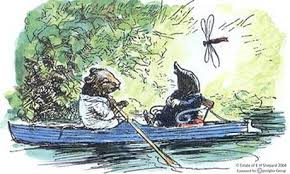The Wind in the Willows Kenneth Grahame
1908
The 100 best novels written in English / The full list
The 100 best novels / No 38 / The Wind in the Willows by Kenneth Grahame (1908)
February 6, 2016
It is an incredibly long time since I last read ‘The Wind in the Willows’, and I returned to it with some nervousness – would it have retained its wit and charm? Unsurprisingly, it is one of those novels which contains depths unnoticed in earlier reads. It is simply wonderful, and if you have a couple of hours spare there are few ways of spending them that would be more rewarding than on the riverbank with Ratty, Mole, Toad, and Badger.
 In an interesting article in the Guardian books column back in 2009, ‘Wild Waters are upon us’, Rosemary Hill observed that ‘The Wind in the Willows’ was written within a few years of Beatrix Potter’s ‘The Tale of Peter Rabbit’, E.Nesbit’s ‘The Railway Children’, and J.M.Barrie’s ‘Peter Pan’. Together she argues, very persuasively, these children’s stories came to define the Edwardian Era, “as an idyllic last summer bathed in golden sunshine“, in contrast to the developments in the real world, “a decade of social discontent and growing international tension, when the cracks in the British Empire began to show“. This novel captures brilliant a world of largely suburban contentment – the animals co-exist quite comfortably with the human world, all except perhaps Mr Toad, and their occupations – mainly messing about on boats – are those of middle class people with time on their hands. If ‘Willows’ creates a lost Edwardian idyll, rather than portraying it, the novel is however quite clear that this world is under threat, from development, urbanisation, and not least the dreaded car. The car must have been a rare and slightly frightening sight in 1908, but the way Graeme captures the petrol-head obsession of Toad has close parallels to the car worship of today.
In an interesting article in the Guardian books column back in 2009, ‘Wild Waters are upon us’, Rosemary Hill observed that ‘The Wind in the Willows’ was written within a few years of Beatrix Potter’s ‘The Tale of Peter Rabbit’, E.Nesbit’s ‘The Railway Children’, and J.M.Barrie’s ‘Peter Pan’. Together she argues, very persuasively, these children’s stories came to define the Edwardian Era, “as an idyllic last summer bathed in golden sunshine“, in contrast to the developments in the real world, “a decade of social discontent and growing international tension, when the cracks in the British Empire began to show“. This novel captures brilliant a world of largely suburban contentment – the animals co-exist quite comfortably with the human world, all except perhaps Mr Toad, and their occupations – mainly messing about on boats – are those of middle class people with time on their hands. If ‘Willows’ creates a lost Edwardian idyll, rather than portraying it, the novel is however quite clear that this world is under threat, from development, urbanisation, and not least the dreaded car. The car must have been a rare and slightly frightening sight in 1908, but the way Graeme captures the petrol-head obsession of Toad has close parallels to the car worship of today.
Graeme’s wonderful conceit in ‘Willows’ was to anthropomorphise his characters, but in a very fluid way. At times they are real animals, and in the edition I read on the kindle the illustrations show them as lifelike, to scale creatures. At other times they are human scale. They have human character traits, but also at other times behave like the animals they are, subject to instincts and urges which nevertheless find an echo in the reader. The cast of characters is hugely strong and well defined; we all know a Ratty, Mole, or Badger, let alone a Toad. The supporting cast of characters is equally well sketched in, so we feel great affection for Otter, for example, or his son, Portly. The Chief Weasel only gets a few lines but that was enough for A.A. Milne to give him a much larger part in the stage version, ‘Toad of Toad Hall’. The narrative is also told with a striking economy – there are only two pages between Toad’s escape from his friends at Toad Hall, and the magistrate passing sentence, “twelve months for the theft…, three years for the furious driving, which is lenient, and fifteen years for the cheek“.

Part of my nervousness about returning to ‘Willows’ lay in the way the Wild Wood and its inhabitants are handled. It is ‘other’ – and can be read as anything alien to the comfortable life of Ratty and company, even if it is home to Badger. At one point the narrator describes it as “low and threatening, like a black reef in some still southern sea“. The alliteration is marvellous, but the point is made – the wild-wooders are like foreigners, tribal natives, dark and threatening. It is like the areas on maps marked ‘here be dragons’. The insurrection of the wild-wooders, numerous and disrespectful to their betters, and at times actually threatening, seemed to me to be a perfect model for the class struggles of the period. The working class are organising and asking why they have to live lives of poverty and drudge, while the middle classes mess around in boats, doing very little. Their revolution, when it comes, is quickly squashed, and it is made clear they have learnt their place, tugging on their forelocks when the squires of the manor pass by. This of course was wishful thinking – the class problems of 20th century Britain were not as easily resolved as a clip around the ear. However I think the handling of this paradigm does throw a light on the complacent attitude of many to the rise of the organised working class in the early years of the 20th century.
I was equally nervous about the “Piper at the Gates of Dawn’ chapter, that strange, surreal story where Ratty and Mole go searching for Otter’s lost son, Portly, and meet him safe in the arms of Pan. Yes, Pan. Mole sees “the backward sweep of the curved horns, gleaming in the growing daylight; saw the stern, hooked nose between the kindly eyes that were looking down on them humorously, while the bearded mouth broke into a half-smile at the corners; saw the rippling muscles on the arms that lay across the broad chest, the long supple hand still holding the pan pipes only just fallen away from the parted lips; saw the splendid curves of the shaggy limbs disposed in majestic ease on the sward“. Pan saves Portly and returns him to his friends, then wipes their memories, Men in Black fashion. It’s still a really strange, slightly homo-erotic chapter. I can only assume Graeme was trying to introduce the idea that the animals have their own spirituality, their own God, but this must have opened up some really difficult lines of thought for God-fearing Edwardians only just coming to terms with Darwinism and their links with the animal kingdom.
 The thing that struck me for the first time on this reading was in relation to the treatment of Toad by his friends when they decide they cannot stand by and see him wreck his life by his addiction to fast cars. The way this is described is almost identical to a modern intervention into the life of a drug addict. His friends sit him down and clearly explain the problem. They describe the waste of money on his addiction, the “regrettable incidents with the police“, and the “weeks in hospital, being ordered about by female nurses“. When he rejects their help they restrain him, keep him under close watch – “he must never be left an instant unguarded. We shall have to take it in turns to be with him, till the poison has worked itself out of his system”. (page 61). Toad has “violent paroxysms” makes “uncouth and ghastly noises“, and lies “prostrate amidst the ruins of chairs” – is not this a wonderfully accurate description of someone going ‘cold turkey’.
The thing that struck me for the first time on this reading was in relation to the treatment of Toad by his friends when they decide they cannot stand by and see him wreck his life by his addiction to fast cars. The way this is described is almost identical to a modern intervention into the life of a drug addict. His friends sit him down and clearly explain the problem. They describe the waste of money on his addiction, the “regrettable incidents with the police“, and the “weeks in hospital, being ordered about by female nurses“. When he rejects their help they restrain him, keep him under close watch – “he must never be left an instant unguarded. We shall have to take it in turns to be with him, till the poison has worked itself out of his system”. (page 61). Toad has “violent paroxysms” makes “uncouth and ghastly noises“, and lies “prostrate amidst the ruins of chairs” – is not this a wonderfully accurate description of someone going ‘cold turkey’.
Finally, to end on a joke, which made me laugh out loud. Toad is in the most liberal dungeon in the country, chatting to the kindly daughter of the warder. She is trying to explain her escape plan, and says:
“I have an aunt who is a washerwoman”,
to which Toad graciously and affably replies
“There, there, …never mind; think no more about it. I have several aunts who ought to be washerwomen”.
Could Bertie Wooster have said it better?



No comments:
Post a Comment